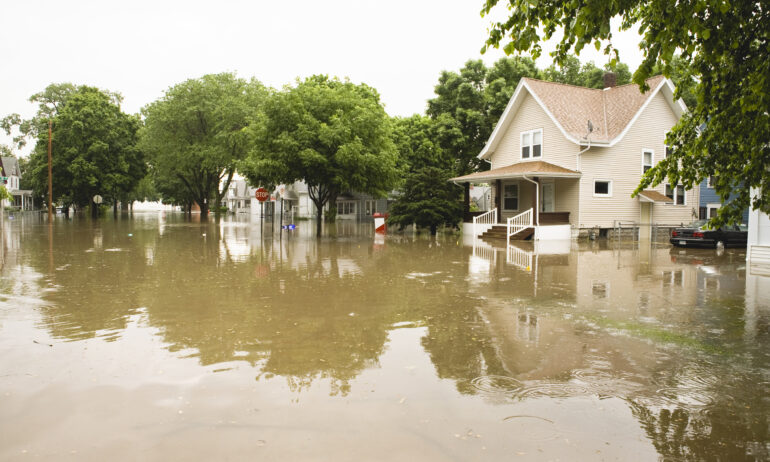Do You Need Flood Insurance?
Your mortgage lender may not require you to buy flood insurance, but your home could still be at risk.

Many, or all, of the products featured on this page are from our advertising partners who compensate us when you take certain actions on our website or click to take an action on their website. However, this does not influence our evaluations. Our opinions are our own. Here is a list of our partners and here's how we make money.
Flooding is the most common natural disaster in the U.S.
If your home floods, a typical home or renters insurance policy won’t cover the damage.
Even properties that aren’t considered “high risk” can flood.
There are online tools you can use to assess your home’s flood risk.
You may not think flooding could ever affect your home. However, 90% of presidentially declared natural disasters in the U.S. involve floods, according to the Federal Emergency Management Agency. And if your home does flood, your homeowners, condo or renters insurance policy isn’t likely to help. That’s why you might need flood insurance, even if you’re not required to buy it.
Get personalized quotes without the work
Let NerdWallet Insurance Experts compare quotes from popular carriers to find the right insurance coverage and rate for you. No guesswork — just expert, personalized help.
NerdWallet Insurance Experts, LLC is a wholly owned subsidiary of NerdWallet.
Why you should consider flood insurance
Below are three reasons you might want to get flood insurance for your home.
Home insurance doesn’t cover flood damage
Many people assume they’re covered for flooding if they have home or renters insurance, but that generally isn’t true. Flooding is different from the water damage these policies usually cover, such as from a burst pipe.
In the insurance industry, flooding is excess water from sources like overflowing rivers, surging tides or rainfall that can’t drain fast enough. Nearly every homeowners and renters policy excludes this type of damage, so if you want coverage, you’ll need separate flood insurance.
The government may not provide much help
Some people don’t buy flood insurance because they assume they can get money from the federal government if their home ever floods.
It’s true that FEMA offers grants if the president declares your state a major disaster area and approves individual assistance in your county. However, the maximum FEMA grant to help flood victims rebuild their homes is $43,600, and most payouts are significantly lower. Compare that to federal flood insurance, which pays up to $250,000 for the structure of your home and $100,000 for your belongings.
You may be able to get more money by taking out a low-interest loan from the Small Business Administration. But unlike a flood insurance payout, you’ll need to pay this money back.
Learn more about how to get money if you don’t have flood insurance.
You may be more at risk than you think
Many people who buy flood insurance do so because they have to. FEMA designates certain places as “special flood hazard areas,” where there’s at least a 1% chance of flooding in any given year. If you live in an SFHA and have a mortgage, your lender will likely require flood insurance. (You can check your home’s flood zone on the FEMA website.)
Not in an SFHA? That doesn’t mean your home is risk-free. About 40% of flood insurance claims are from low- or moderate-risk areas, according to FEMA.
And that percentage reflects only people who have flood insurance. When Hurricane Helene struck western North Carolina in 2024, less than 1% of residents in hard-hit Buncombe County had federal flood insurance, according to the Insurance Information Institute.
The price of flood insurance is based in part on your level of risk — so if you live outside an SFHA, you might be able to get coverage for a relatively affordable price. Learn more about the average cost of flood insurance.
How to assess your flood risk
While FEMA’s maps are a good starting point, they can be outdated. FEMA has historically focused on coastal and river flooding, so its maps often underestimate the risk of flooding from heavy rainfall. Because a warming atmosphere can hold more moisture and produce more rain, many scientists believe this type of flooding will become more common with climate change.
Private companies and nonprofit organizations have stepped in to provide alternative flood risk models that incorporate climate change data. One example is First Street, a private benefit corporation that can estimate your property’s flood risk on a scale of 1 to 10. Climate Check is another option, providing flood risk ratings on a scale of 1 to 100.
Climate Central, a nonprofit news organization focused on climate change, offers a Coastal Risk Finder that you can use to project future flood risk in coastal communities under a variety of scenarios.
Note that “a model is a model,” and not a definitive forecast of what’s going to happen, says Matthew Eby, founder and CEO of First Street. These online tools can help you get a sense of your home’s risk, but they’re not foolproof.
If you’re concerned about your home’s chance of flooding, Eby recommends doing further research by speaking with your community’s flood plain manager. Your state or municipal government can help you find their contact information.
Buying a new home? Ask the seller whether the house or neighborhood has ever flooded in the past. Certain states such as Texas and Louisiana require sellers to share this information.
How to get flood insurance
Most people buy flood insurance through the National Flood Insurance Program. These policies are administered by FEMA and sold by insurers like Allstate and Farmers. A full list of providers is on the NFIP’s website.
Depending on where you live, you may also be able to shop around with private flood insurers to get better coverage or lower rates. A local insurance agent can help find the best flood insurance for you.
Alternatives to flood insurance
Not everyone needs flood insurance. If you live in a lower-risk area, you may want to weigh the cost of coverage against the likelihood of having to file a claim.
Self-insure
If your area has never had serious damage and you’re thinking of skipping flood insurance, consider setting aside money for possible repairs. For instance, you may want to open a high-yield savings account where you keep funds for floods or other emergencies.
Some states — including Mississippi, Alabama and South Carolina — allow residents to put emergency funds in Catastrophe Savings Accounts, which can be used to fund repairs after a flood. You don’t need to pay state income taxes on the money that you put into these accounts or on the interest it earns.
However, you may still need to pay federal income taxes on that money, and you could face a penalty tax from the state if you spend it on anything besides disaster repairs.
Lower your flood risk
If you can’t afford flood insurance or you need other ways to reduce your risk, consider these tips.
Elevate expensive items. Eby recommends putting pricey appliances such as heating or air-conditioning units on raised platforms, which is generally cheaper than elevating your entire house.
Protect your basement. Sealing your basement’s walls with a waterproofing compound may help keep floodwaters out. Have a sump pump remove any water that does get in.
Install flood vents. These openings in your foundation can prevent structural damage by allowing water to flow freely into and out of your home’s lowest level.
Use sandbags. Placing plastic sheeting over your doors and then covering it with sandbags can be an effective way to keep water out of your house. You can buy your own sandbags or, in some cases, get them for free from your local government when a storm is on the way.
Consider community solutions. There’s only so much you can do to protect your home if the flood risk originates beyond your property. That’s why Eby encourages homeowners to get together with neighbors and local governments to see if investments in seawalls, levees or upgraded drainage systems could reduce flood risk on a broader scale. After all, Eby says, “The property is only as valuable as the community it’s a part of.”
Learn more about how to protect your home from climate change.





